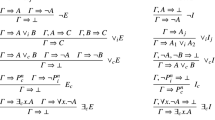Abstract
In this paper we provide a uniform framework, based on extraction calculi, where to study the complexity of the problem to decide the disjunction and the explicit definability properties for Intuitionistic Logic and some Superintuitionistic Logics. Unlike the previous approaches, our framework is independent of structural properties of the proof systems and it can be applied to Natural Deduction systems, Hilbert style systems and Gentzen sequent systems.
Preview
Unable to display preview. Download preview PDF.
Similar content being viewed by others
References
A. Avellone, M. Ferrari, and C. Fiorentini. A formal framework for synthesis and verification of logic programs. In K.-K. Lau, editor, Logic Based Program Synthesis and Transformation, 10th International Workshop, LOPSTR 2000, Selected Papers, volume 2042 of Lecture Notes in Computer Science, pages 1–17. Springer-Verlag, 2001.
S. Buss and G. Mints. The complexity of the disjunction and existential properties in intuitionistic logic. Annals of Pure and Applied Logic, 99(3):93–104, 1999.
S. Buss and P. Pudlák. On the computational content of intuitionistic propositional proofs. Annals of Pure and Applied Logic, 109(1–2):49–64, 2001.
M. Ferrari. Strongly Constructive Formal Systems. PhD thesis, Dipartimento di Scienze dell’Informazione, Universitá degli Studi di Milano, Italy, 1997. Available at http://homes.dsi.unimi.it/~ferram.
M. Ferrari and C. Fiorentini. A proof-theoretical analysis of semiconstructive intermediate theories. Studia Logica, to appear.
M. Ferrari, C. Fiorentini, and P. Miglioli. Goal oriented information extraction in uniformly constructive calculi. In Argentinian Workshop on Theoretical Computer Science (WAIT’99), pages 51–63. Sociedad Argentina de Informática e Investigación Operativa, 1999.
M. Ferrari, P. Miglioli, and M. Ornaghi. On uniformly constructive and semicon-structive formal systems. Logic Journal of the IGPL, to appear.
C. Fiorentini and P. Miglioli. A cut-free sequent calculus for the logic of constant domains with a limited amount of duplications. Logic Journal of the IGPL, 7(6):733–753, 1999.
D.M. Gabbay. Semantical Investigations in Heyting’s Intuitionistic Logic. Reidel, Dordrecht, 1981.
S. Görnemann. A logic stronger than intuitionism. Journal of Symbolic Logic, 36:249–261, 1971.
G. Kreisel and H. Putnam. Eine Unableitbarkeitsbeweismethode für den intuition-istischen Aussagenkalkül. Zeitschrift für Mathematische Logik und Grundlagen der Mathematik, 3:74–78, 1957.
P. Miglioli, U. Moscato, and M. Ornaghi. Constructive theories with abstract data types for program synthesis. In D.G. Skordev, editor, Mathematical Logic and its Applications, pages 293–302. Plenum Press, New York, 1987.
P. Miglioli, U. Moscato, and M. Ornaghi. Abstract parametric classes and abstract data types defined by classical and constructive logical methods. The Journal of Symbolic Computation, 18(1):41–81, 1994.
H. Ono. Some results on the intermediate logics. Publications of the Research Institute for Mathematical Sciences, Kyoto University, 8:117–130, 1972.
C.A. Smorynski. Applications of Kripke semantics. In A.S. Troelstra, editor, Metamathematical Investigation of Intuitionistic Arithmetic and Analysis, volume 344 of Lecture Notes in Mathematics, pages 324–391. Springer-Verlag, 1973.
A.S. Troelstra, editor. Metamathematical Investigation of Intuitionistic Arithmetic and Analysis, volume 344 of Lecture Notes in Mathematics. Springer-Verlag, 1973.
A.S. Troelstra and H. Schwichtenberg. Basic Proof Theory, volume 43 of Cambridge Tracts in Theoretical Computer Science. Cambridge University Press, 1996.
Author information
Authors and Affiliations
Editor information
Editors and Affiliations
Rights and permissions
Copyright information
© 2002 Springer-Verlag Berlin Heidelberg
About this paper
Cite this paper
Ferrari, M., Fiorentini, C., Fiorino, G. (2002). On the Complexity of Disjunction and Explicit Definability Properties in Some Intermediate Logics. In: Baaz, M., Voronkov, A. (eds) Logic for Programming, Artificial Intelligence, and Reasoning. LPAR 2002. Lecture Notes in Computer Science(), vol 2514. Springer, Berlin, Heidelberg. https://doi.org/10.1007/3-540-36078-6_12
Download citation
DOI: https://doi.org/10.1007/3-540-36078-6_12
Published:
Publisher Name: Springer, Berlin, Heidelberg
Print ISBN: 978-3-540-00010-5
Online ISBN: 978-3-540-36078-0
eBook Packages: Springer Book Archive




